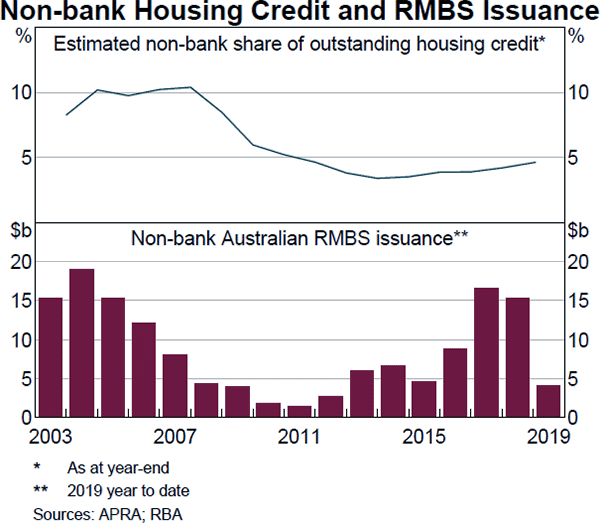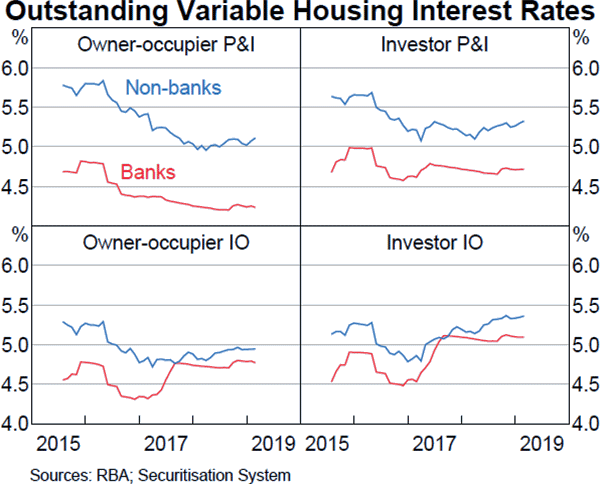Financial Stability Review – April 2019 Box D: Non-bank Lending for Property
Over the past three years, there has been a shift in lending for property towards non-ADI lenders (referred to as non-bank lenders in this box). Residential mortgage lending by non-banks is estimated to have been growing much faster than the rate of banks' mortgage lending. Non-bank lending to property developers has also grown at a fast pace. Non-bank lenders perform similar functions to banks and lend to a wide range of borrowers. They finance their lending by securitising loans or with funding from private investors, such as high net worth individuals and institutional investors. Non-bank lenders are prohibited from accepting deposits, and are therefore not prudentially regulated.
Non-bank lending supports economic growth by providing an alternative form of funding and increasing competition for lending. But the activities of non-bank lenders can pose risks to financial stability, as they have in some countries internationally. These risks arise when non-banks exacerbate credit and asset price cycles, prompt banks to weaken their lending standards or have financial links with the banking sector that see credit losses at non-banks transmitted to banks. This box assesses these risks today, in light of the recent pick-up in growth of non-bank property lending.
Non-bank mortgage lending has grown rapidly …
Non-bank residential mortgage lending is estimated to have grown by roughly 15 per cent per annum over recent years, well above growth in lending by banks. This has seen their market share of outstanding lending continue to trend up (Graph D1). While these estimates are based on incomplete data that may be revised over the coming year, they are broadly consistent with the information available on non-banks' liabilities. Almost all non-bank mortgage lending is funded by issuing residential mortgage-backed securities (RMBS) and non-bank issuance of these securities has trebled over the past three years. The flow of non-bank RMBS issuance in 2018 was close to the pre-crisis peak.

A factor that had supported non-banks' increased market share has been banks' repricing of certain types of housing loans. Specifically, banks have increased the interest rates they charge on investor and interest-only (IO) loans, which are now on average around 50 basis points higher than interest rates on owner-occupier principal and interest loans. Banks increased interest rates on these products as a way of meeting the investor and IO lending benchmarks introduced by the Australian Prudential Regulation Authority (APRA) in 2014 and 2017. Non-bank lenders, which were not required to meet APRA's benchmarks, often do not apply this differential to investor and interest-only loans. These benchmarks have both been removed for most lenders. But other prudential standards are changing, as have perceptions of risk, so, to date, banks' interest rate differentials based on type of loan remain. Data from the RBA's Securitisation Dataset show that non-banks generally charge higher interest rates than banks for owner-occupier principal and interest loans; however, the interest rates they charge on other loans are typically much closer to those charged by banks (Graph D2).[1] As a result, investor loans have made up a growing proportion of non-bank lending, while their proportion of IO loans has fallen by much less than banks (Graph D3). In contrast, banks have retreated from both these market segments.


In addition, a perception that finance is more difficult to obtain from the major banks has seen even some higher quality borrowers shifting to non-bank lenders. The RBA's liaison with non-bank lenders indicates that borrowers have been attracted by their faster approval times and the greater likelihood of approval compared with the major banks.
… but remains small and financial stability risks are limited at this point
Non-bank mortgage lenders account for less than 5 per cent of outstanding housing credit and so are not a substantial financial stability risk (Graph D1). In particular, their small share reduces the risk that non-bank lenders will exacerbate the credit cycle. More generally, growth in non-bank lending has accelerated as housing markets and credit growth have both been weakening overall.
There is also no evidence of banks loosening lending standards to compete. Banks have instead tightened lending standards since 2015, although there continues to be strong competition for the highest quality borrowers. Non-bank lenders have also tightened their lending standards over recent years, even while writing a larger share of higher risk investor loans than previously. This is because they are still subject to responsible lending laws, for which compliance expectations have increased over recent years, and because long-term investors often expect non-bank RMBS to broadly conform with APRA standards. Consistent with this, arrears rates for non-bank lenders are slightly lower than for banks and have not increased materially to date. Whether this would remain true if the unemployment rate was to rise remains to be seen.
The potential for contagion from non-banks to banks also remains small because interconnections between them are limited. Banks have some exposure to non-bank mortgage lending through short-term ‘warehouse’ funding facilities, but these are small compared with banks' own mortgage lending and their capital. Banks' willingness to increase these exposures significantly is limited by APRA monitoring the growth of these facilities, a liquidity requirement to match the undrawn exposures with high-quality liquid assets, and the capital required to be held against such exposures.
The main constraints to a more rapid expansion of non-bank mortgage lending stem from their funding. RMBS pricing is well above the cost of bank funding (deposits or senior unsecured bank debt) and remains significantly higher than pre-crisis levels. The cost of funding from RMBS markets has also risen significantly since early 2018, reflecting both a rise in spreads on RMBS and the increase in the bank bill swap rate, which forms the base for RMBS pricing. This means that non-bank lenders will struggle to compete with banks for the highest quality owner-occupier principal and interest mortgages, unless they are able to secure alternative long-term funding. In addition, it does not currently appear feasible to significantly increase the capacity of RMBS markets. This is because the investor base for such instruments is relatively narrow and securing new investors has been a prolonged and challenging task.
Non-bank lending to property developers is also growing fast, and poses more risk
The pick-up in non-bank lending to property developers has occurred as banks pulled back from this market due to concerns about increased risks. Non-bank lending for property development has come from a range of sources, but the most prominent providers have been managed funds that specialise in financing property development. This lending is mostly funded by equity investments from wealthy individuals and institutional investors, including foreign funds. This is an area where data are very limited; however, liaison contacts report that non-bank financing of property development is widely available and still growing strongly, especially in Melbourne. Non-bank lenders generally require lower levels of pre-sales than banks and allow greater leverage for borrowers, but also charge much higher interest rates. Pre-sales became harder to achieve as the property market cooled, and this contributed to the demand for non-bank financing from developers.
If more marginal developments proceed, because developers are able to obtain funding from non-bank lenders, the boost to supply would place further downward pressure on property prices. This could have flow-on implications for banks' property portfolios (see ‘Box C: Risks in High-density Apartment Markets’). In particular, the performance of banks' exposures to property developers would deteriorate if apartment sales and prices experience further significant declines and settlement failures rise. However, much of the lending by non-banks is expensive mezzanine debt (debt which is ranked below senior debt in the capital structure). This debt is relatively expensive and so reduces the likelihood that low-return projects will proceed, minimising the financial stability risk. Further, this mezzanine lending is subject to some external oversight because when a bank provides the senior debt it has visibility of the mezzanine debt and the risks this may pose to the developer. This oversight may diminish as non-bank involvement in senior debt is becoming more common.
More comprehensive data on non-bank lending will help to monitor the risks
The financial stability risks from non-bank property lending are judged to be limited at this point, although risks associated with property development bear watching. Incomplete data on non-bank lending activity currently make it challenging to assess these risks. However, legislation passed in March 2018 expanded APRA's data collection powers to encompass a wider range of non-bank entities. Since then, a working group, consisting of APRA, the Australian Bureau of Statistics and the RBA, has been working to improve the coverage of non-bank data. This should help APRA and the RBA in their ongoing monitoring of financial stability risks arising from non-bank lending.
Footnote
Non-banks offer very competitive interest rates for a small proportion of owner-occupiers with lower credit risk, such as those with stable incomes and low LVRs. The margins on loans priced at these rates tend to be small, but the presence of higher-quality loans makes it easier to sell RMBS. Non-bank lenders also offer loans with interest rates of 6 per cent or more, which tend to be to non-conforming borrowers that are of higher credit risk and find it more difficult to obtain bank credit. [1]